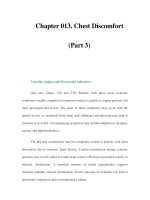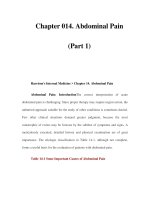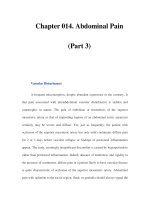Chapter 089. Pancreatic Cancer (Part 1) pdf
Bạn đang xem bản rút gọn của tài liệu. Xem và tải ngay bản đầy đủ của tài liệu tại đây (13.22 KB, 5 trang )
Chapter 089. Pancreatic Cancer
(Part 1)
Harrison's Internal Medicine > Chapter 89. Pancreatic Cancer
Pancreatic Cancer: Introduction
Over 90% of pancreatic cancers are ductal adenocarcinomas of the exocrine
pancreas. These tumors occur twice as frequently in the pancreatic head compared
to the rest of the organ, and tend to be aggressive, often presenting when locally
inoperable or after distal metastases have occurred. Patients with pancreatic cancer
have a poor prognosis, with a 5-year survival of only 5%. The discussion of
pancreatic cancer here will be limited to ductal adenocarcinomas. Other types of
pancreatic neoplasms include islet cell tumors and neuroendocrine tumors (Chap.
344).
Incidence and Etiology
Epidemiology
The lifetime risk of being diagnosed with pancreatic cancer in the United
States is 1.27%. In the United States, it is estimated that approximately 37,170
people will be diagnosed with pancreatic cancer in 2007. Consistent with its
associated poor prognosis, 33,370 are expected to die from this disease in the same
year, making it the fourth leading cause of cancer-related death. The median age
of diagnosis of pancreatic cancer is 72 years, with the peak incidence of diagnosis
between the ages of 65 and 84; it is rarely diagnosed in those below the age of 50.
The incidence is slightly higher in men than women, and it is also higher in
African Americans than in Caucasians.
Etiology
Cigarette smoking, obesity, and nonhereditary chronic pancreatitis appear
to be risk factors for the development of pancreatic cancer. With smoking, the risk
seems to increase with the number of cigarettes consumed and decreases with
smoking cessation. Less clear, and sometimes conflicting associations, have been
observed for other environmental factors such as diet, coffee and alcohol
consumption, previous partial gastrectomy or cholecystectomy, and Helicobacter
pylori. An epidemiologic association between diabetes mellitus and pancreatic
cancer has also been demonstrated; however, it is uncertain if diabetes is a
precedent of, or consequence of, pancreatic cancer.
Genetic Considerations
Five to 10% of patients with pancreatic cancer also have an affected first-
degree relative, suggesting that in some cases genetic factors are involved. These
patients seem to present earlier than sporadic cases. The risk of pancreatic cancer
is increased in certain syndromes, whether directly or indirectly, such as hereditary
chronic pancreatitis, Peutz-Jeghers syndrome, Von Hippel-Lindau syndrome,
familial atypical multiple-mole melanoma syndrome, ataxia-telangiectasia,
Gardner's syndrome [a variant of familial adenomatous polyposis (FAP)] and
Lynch syndrome II, a subtype of hereditary nonpolyposis colorectal cancer
(HNPCC). Heavy smokers who also have homozygous deletions of the gene for
glutathione-S transferase T1 (GSTT1), a carcinogen metabolizing enzyme, may be
at particular risk. Activating mutations in the K-ras oncogene are found in nearly
all pancreatic cancer. Loss-of-function mutations in several tumor suppressor
genes occur in this disease, including p53, CDKN2A gene (also called multiple
tumor suppressor-1 gene, leading in many cases to loss of function of p16), DPC4,
and BRCA2. A feature almost unique to pancreatic cancer is the combination of K-
ras and CDKN2A mutations.
Clinical Features
Presenting Features
Common presenting features of pancreatic cancer include pain (present in
>80% of patients with locally advanced or metastatic disease), obstructive
jaundice, weight loss, and anorexia. Patients with jaundice may also have pruritus,
pale stools, and dark urine; they often have tumors in the pancreatic head, and tend
to be diagnosed earlier and with earlier stage disease. Other symptoms tend to be
more insidious, so that in the absence of jaundice, the interval between onset and
diagnosis can be prolonged. Pain, for example, is often more of a problem in
patients with lesions in the body or tail of the pancreas where the primary tumor is
more likely to become quite large or to invade adjacent structures (such as the
splanchnic nerves) before becoming manifest; these patients frequently have
inoperable disease. When present, pain is often felt as a dull ache in the upper
abdomen and may radiate to the back, and characteristically may improve upon
leaning forward. It may initially be intermittent, and may worsen with meals.
These patients may suffer from marked weight loss, which may result from a
combination of anorexia, early satiety, malabsorption or diarrhea/steatorrhea.
Other less common presenting features include the diagnosis of glucose
intolerance (particularly within 2 years of cancer diagnosis), previous pancreatitis,
migratory superficial thrombophlebitis (Trousseau's syndrome), gastrointestinal
hemorrhage from varices, and splenomegaly.









